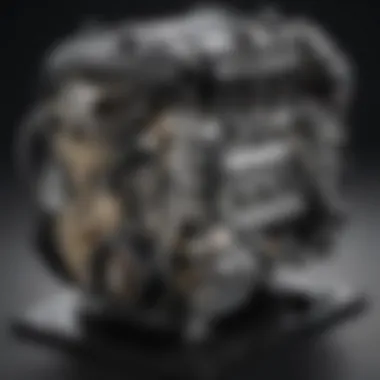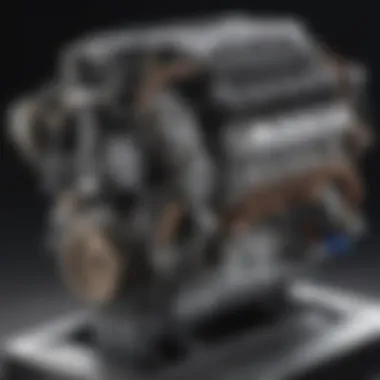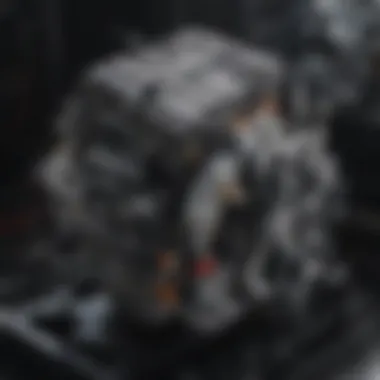Engine Performance Analysis of the 2004 Toyota Matrix


Intro
The 2004 Toyota Matrix represents an intriguing chapter in the annals of compact vehicles, perfectly blending practicality with performance. Designed as a versatile hatchback, it caters to a broad audience ranging from young professionals to families seeking a reliable ride. Understanding the engine dynamics of this vehicle is crucial, not just for potential buyers, but also for automotive enthusiasts and industry analysts. This engine is not just a collection of parts; it embodies the intersection of engineering precision and consumer expectations.
At the heart of the Matrix, you will find a balanced mix of design and performance, which sets it apart from its competitors in the market. From its powertrain to its emission standards, every aspect of the engine tells a story worth analyzing. By dissecting the Matrix's engine specifications, we can highlight its relevance in the ever-evolving compact vehicle segment. Moreover, evaluating how these factors play into current market trends and future projections can provide deeper insights into its competitive standing.
Here, we’re going to delve deeper into aspects such as market trends, industry challenges, and ever-emerging technologies that impact the performance and perception of the 2004 Toyota Matrix in the automotive landscape. Let's get started.
Prologue to the Toyota Matrix Engine
Engines are at the heart of any vehicle, and analyzing the Matrix's engine can shine a light on both its strengths and shortcomings. By diving into this discussion, we’ll uncover how the engine integrates with the overall driving experience and why it remains significant in its segment today. The rational choice of an effective engine design combines power, fuel efficiency, and reliability, making this model a compelling contender in the compact market.
Overview of the Toyota Matrix
The 2004 Toyota Matrix presented itself as an intriguing option in the compact hatchback field. Built on the Corolla platform, it shared numerous elements that amplified its appeal. With a spacious cabin, it offered flexibility whether for daily commuting or family road trips. Its styling—a unique fusion of hatchback and SUV—stood apart in a sea of sedans, hinting at its adventurous nature.
Under the hood, drivers could choose between two engine options: a practical 1.8L four-cylinder or a more robust 2.4L engine for those craving extra power. The Matrix catered to wide-ranging preferences, allowing buyers to select between fuel efficiency and spirited driving performance. This thoughtful design consideration helped solidify its place in a competitive market.
Significance of Engine Performance
When discussing automobiles, engine performance isn't just about horsepower and torque; it's an intersection of efficiency, responsiveness, and driving pleasure. In the context of the 2004 Toyota Matrix, engine performance translates to how well it meets the everyday needs of various drivers while retaining its distinctive charm.
- Daily Driving Needs: For many drivers, traversing city streets or winding roads requires a reliable engine that can balance power and efficiency. The Matrix effectively fulfills this need, making it a practical option for commuting.
- Adventure Ready: Equipped engines provide sufficient torque for brisk acceleration when necessary, enabling confident merging or overtaking.
- Overall Value: Strong engine performance enhances the vehicle's resale value as buyers tend to favor models renowned for reliability and efficiency.
In summary, the 2004 Toyota Matrix engine dynamics represent much more than just specs on paper; they encapsulate what makes the vehicle viable for a variety of lifestyles.
Engine Specifications
When discussing the engine of the 2004 Toyota Matrix, it’s essential to zero in on engine specifications. These details do not merely fill up pages in a manual; they’re the heartbeat that determines how the vehicle performs on the road, interacts with the driver, and experiences wear over time. Understanding the nuances of engine specifications empowers automotive enthusiasts, potential buyers, and mechanics alike to make informed decisions about what to expect from the Matrix, how to maintain it, and troubleshoot potential issues down the line.
Engine Types in the Matrix
1.8L Four-Cylinder Engine
The 1.8L four-cylinder engine is often touted as the entry-level choice for the Matrix. This engine provides a competitive balance of power and efficiency. It’s designed with fuel economy in mind, making it particularly intriguing for city dwellers who end up stopping and starting frequently.
One of the key characteristics of this engine is its lightweight construction, which contributes to its nimble handling and responsiveness. Drivers appreciate its efficient use of fuel, managing to clock significant miles without guzzling gas. It may not push limits in terms of power, but its performance within the compact class is more than decent. This engine features a variable valve timing system that enhances throttle response, making it a popular option.
However, its limitations do come into play for those seeking robust power for rapid highway overtakes or spirited drives in hilly terrains. It excels in everyday usability but might leave some longing for more excitement on expansive roads.
2.4L Four-Cylinder Engine
On the flip side, the 2.4L four-cylinder engine in the Matrix serves as a step-up, catering to drivers yearning for a more dynamic experience. This engine can produce higher horsepower and torque, translating to better acceleration and a more thrilling driving dynamic.
One distinguishing feature is its increased torque delivery at lower RPMs, which translates to quicker starts and a more engaging driving experience, especially when fully loaded or navigating up inclines. Many find that this engine doesn’t just feel stronger but also offers improved responsiveness overall, making it a favorite among those who prioritize performance.
Nevertheless, with might comes a bit more fuel consumption. If you’re after those miles per gallon like a hawk, be ready to fill up a little more often than with the smaller engine.
Power and Torque Ratings
Maximum Horsepower
The maximum horsepower of the 2004 Toyota Matrix's engines is a central figure that often draws attention. For the 1.8L engine, it can generate around 126 horsepower, while the 2.4L pushes out a notable 158 horsepower. This disparity highlights the different target markets for these engine choices.
The 126 hp may feel like a solid number for routine driving, yet the snappier acceleration from the 158 hp makes daily commutes feel a tad more invigorating. For those who need to merge quickly onto a highway or navigate busy urban streets, this horsepower can offer a sense of security that the smaller engine might not provide.
Torque Characteristics


Torque characteristics are just as vital, if not more so, than horsepower in gauging performance, especially in real-world scenarios where instant power is needed. The 1.8L engine delivers 122 lb-ft of torque, while the 2.4L ups that significantly to 162 lb-ft.
This notable difference makes all the difference during acceleration and while carrying heavier loads. The torque from the 2.4L engine provides a more satisfying driving experience, making it easier to navigate through city traffic without having to constantly downshift for that extra push.
Fuel Efficiency Metrics
City vs. Highway Mileage
A vital metric for nearly any vehicle is its fuel efficiency, and the 2004 Toyota Matrix does not disappoint on this front. The 1.8L engine offers impressive city mileage, hovering around 26 mpg, and even better on highways, reaching 33 mpg. On the other hand, the 2.4L holds its own, averaging 24 mpg in city conditions and approximately 31 mpg on the highway.
These numbers appeal directly to budget-conscious buyers who want to maximize their fill-ups. But let's not kid ourselves; the Matrix is not just about hauling passengers. Its robustness allows for transporting cargo without feeling like you're dragging a lead anchor through mud.
Fuel Type Considerations
The 2004 Toyota Matrix operates primarily on regular unleaded gasoline, which is a critical consideration for users looking to cut down on fuel expenses. Especially when comparing with rivals that may recommend premium fuel, this aspect positions the Matrix as an accessible option for daily drivers.
Having the ability to run on regular fuel broadens its appeal, as it simplifies the process for consumers who are wary of fluctuating fuel prices. However, it’s also important to realize that power enthusiasts might perceive a decline in performance with lower-grade fuel. This becomes a trade-off:
- Budget-friendly with regular fuel
- Performance might dip versus premium users
Overall, understanding the engine specifications of the 2004 Toyota Matrix provides a clearer picture of its capabilities. From power ratings to fuel efficiency, each aspect integrates seamlessly into a vehicle that aims to deliver not just utility but also driving enjoyment.
Engine Design and Features
The engine design and features represent the backbone of the 2004 Toyota Matrix, playing a pivotal role in determining its performance, efficiency, and overall driving experience. A carefully considered design prevents issues and enhances longevity, thereby impacting the vehicle's value over time. In this section, we delve into the core materials used in construction, as well as technological advancements that keep this engine relevant in today's market.
Engine Construction Materials
Engine Block Composition
The engine block composition of the 2004 Toyota Matrix is primarily made of cast iron. Cast iron is a common choice in engine design for good reason; its strength and durability can withstand high operating pressures and temperatures. This not only supports the engine structure effectively but also contributes to better heat retention, which is critical in maintaining optimal operational temperature.
Moreover, this type of material allows for better wear resistance, resulting in fewer repairs and extended engine life. One unique feature of cast iron is its capability to handle high torque, something that is beneficial when the vehicle is under load during acceleration. However, one should consider that cast iron engines can be heavier, which may slightly affect fuel economy and overall handling.
Cylinder Head Materials
When examining cylinder head materials, the 2004 Toyota Matrix employs aluminum. Aluminum is known for its lightweight properties, which greatly contribute to reducing the overall weight of the engine. This helps in achieving better fuel efficiency and enhances the dynamics of the vehicle. The heat conductivity of aluminum allows for efficient heat dissipation, preventing the engine from overheating during prolonged use.
On the downside, aluminum is less resistant to high temperatures and stresses compared to cast iron. It may require a bit more attention during maintenance, as any cracks or warping can lead to expensive repairs. Ultimately, the choice of aluminum for the cylinder head aligns well with the Matrix's goals of performance and efficiency, despite the inherent challenges.
Advancements in Engine Technology
Advancements in engine technology underscore the importance of innovation in the 2004 Toyota Matrix, enhancing performance while meeting emissions standards. These advancements have not only improved the driving experience but also the vehicle's appeal in a competitive market.
Dual VVT-i System
The dual Variable Valve Timing with intelligence (VVT-i) system is one significant advancement found in the 2004 Matrix. This system optimizes intake and exhaust valve timing, adjusting the timing based on engine speed and load conditions. The key characteristic here is the improved engine efficiency and power output, allowing the Matrix to deliver solid performance without sacrificing fuel economy.
This technology offers the benefit of providing ample torque across a wide range of RPMs, making the driving experience more responsive, particularly in urban driving scenarios. However, while the system adds complexity, it remains an attractive feature that boosts the vehicle’s market appeal, catering to drivers wanting both practicality and performance.
Electronic Fuel Injection
Electronic fuel injection (EFI) is another technology integral to the engine's performance. Unlike older mechanical systems, EFI allows for precise control over the amount of fuel injected into the engine. This results in a more efficient combustion process, which improves fuel economy and reduces harmful emissions.
The unique capability of EFI to adapt to changing driving conditions means that the engine can operate at optimal efficiency more of the time. Nonetheless, like the dual VVT-i system, the electronic fuel injection introduces additional components that may increase maintenance costs over time. Still, its advantages outweigh potential drawbacks, cementing its status as a critical element of the Matrix's design.
In summary, the engine design and features of the 2004 Toyota Matrix showcase a thoughtful blend of material selection and innovative technology, aiming to deliver an impressive balance of performance and efficiency.
Performance Analysis


Performance analysis in the 2004 Toyota Matrix is a critical element as it gives potential buyers and enthusiasts insights into how well the vehicle performs under various driving conditions. This analysis encompasses several key factors: acceleration, handling, and overall driving experience. Understanding these dynamics helps assess the Matrix’s competitiveness in the compact car market. An efficient performance can lead to enhanced user satisfaction and a more enjoyable driving experience.
Acceleration and Handling
0-60 mph Times
The 0-60 mph time is often regarded as a benchmark for assessing a vehicle's performance capability. For the 2004 Toyota Matrix, the standard 1.8L engine offers an acceleration time of approximately 8.0 seconds when engaging in a full throttle start. This characteristic helps paint a vivid picture of its peformance in urban and highway driving scenarios. The Matrix’s ability to reach highway speeds without needing excessive time is a valuable point in its favor.
While not the fastest in its class, this acceleration time can be seen as satisfactory for daily driving. Owners may appreciate the balance between power and fuel efficiency, making it a popular choice for practical uses like commuting. However, it may not be exhilarating for those who chase peak performance.
Suspension Interaction
Suspension interaction plays a profound role in the overall handling of the Matrix. The vehicle employs a MacPherson strut front suspension and a trailing beam rear suspension, which collectively offer a blend of comfort and responsive handling. This setup is key for maintaining stability and control, particularly during spirited drives or sharp turns.
One notable feature here is the way the suspension absorbs bumps and uneven road surfaces, promoting driver confidence and minimizing discomfort. This can be especially advantageous in urban environments where potholes and irregularities are common. Its handling characteristics, while not sporty, strike a decent balance, providing drivers with decent feedback while remaining forgiving enough for everyday use.
Driving Experience
Road Noise Levels
Road noise levels are an often-overlooked aspect of driving comfort. In the 2004 Toyota Matrix, cabin insulation is reasonably effective, limiting intrusive sounds from reaching the interior. Although some noise is present during higher speeds—especially from wind and tires—most users find it acceptable for a compact vehicle.
This characteristic has significant implications for long drives or commutes where cabin quietness contributes to a more relaxed driving atmosphere. However, it’s also a reminder that the Matrix, being built with efficiency in mind, might not rival higher-end models known for their quietness.
Ride Comfort
Ride comfort is another essential feature in evaluating the driving experience. The Matrix provides a commendable level of comfort, ensuring that occupants don't feel every bump in the road. The seating is designed to support long drives, and the overall setup aims to minimize fatigue during everyday commutes.
While it may lack the plushness of luxury vehicles, users frequentlty acknowledge that it satisfactorily meets the demands of daily driving without causing strain. However, on extremely rough surfaces, its compact design may cause a tad bit of jarring, hinting at a slight trade-off between comfort and sportiness.
In the world of compact cars, understanding performance dynamics such as acceleration, handling, ride comfort, and noise levels is crucial for making a well-informed choice.
The performance analysis of the 2004 Toyota Matrix showcases its potential for efficient urban driving, balancing power, comfort, and handling while keeping usability in mind. It represents a solid option for those seeking reliability and reasonable performance in a compact vehicle.
Engine Longevity and Maintenance
The longevity and maintenance of the engine are crucial factors that contribute directly to the overall performance and reliability of the 2004 Toyota Matrix. Keeping the engine in peak condition not only enhances driving satisfaction but also guards against costly repairs down the line. A well-maintained engine can improve fuel efficiency, reduce emissions, and maintain a higher resale value. When assessing vehicles, especially used ones, the state of the engine is often a significant indicator of the car’s previous care and usage.
Oil Change Intervals
Regular oil changes are the lifeblood of an engine. For the 2004 Toyota Matrix, following the manufacturer's recommended oil change intervals is vital. This typically falls around every 5,000 miles with conventional oil, and up to 7,500 miles if using synthetic oil.
- Why stick to these intervals?
- Engine oil lubricates components, reducing friction and wear.
- Fresh oil helps remove contaminants that build up over time.
- Regular changes prevent sludge from forming, which can lead to serious engine problems.
Neglecting oil changes could lead to more than just decreased performance; it could result in engine failure. A well-timed oil change acts like a shield, ensuring that the vital parts work smoothly.
Common Engine Issues
Despite its robust design, certain issues can crop up with the 2004 Toyota Matrix engine. Here are some common pitfalls that owners might face:
- Oil Leaks: Over time, worn gaskets and seals may lead to oil leaks, which could cause the engine to run low on oil, increasing wear.
- Overheating: Whether from a malfunctioning thermostat or a failing water pump, overheating can swiftly damage the engine.
- Timing Chain Problems: Some Matrix models have reported issues with timing chains, which can lead to significant performance problems.
Being aware of these potential issues equips owners to take proactive steps. Regular inspections and keeping an ear out for unusual noises can make all the difference. Like they say, an ounce of prevention is worth a pound of cure.
"Addressing minor problems early on prevents them from developing into major headaches later."
Keeping the 2004 Toyota Matrix in top shape is not just about the engine alone; it requires dedicated attention to all components of the vehicle. Therefore, understanding and acting upon the factors affecting engine longevity and maintenance ensures a stable and effective performance for many miles to come.


Market Positioning
The compact segment has exploded over the years, with various manufacturers jockeying for position. This level of competition means that consumers are often given more than just basic promises; they want assurance that what they’re driving can stand the test of time, performance, and reliability. Here, a car like the Matrix stands out, merging fuel efficiency with solid performance.
Comparative Analysis with Rivals
Competitors in Compact Segment
In the compact segment, the Toyota Matrix faced off against various challengers like the Honda Civic, Ford Focus, and Mazda 3. Each competitor has aimed to offer a distinctive blend of style, performance, and price. What sets the Matrix apart is its unique blend of versatility and reliability. For instance:
- Honda Civic: This car has a sporty persona, known for its zip and youthful branding.
- Ford Focus: Targets a slightly different demographic with a more robust feel and a reputation for engaging driving dynamics.
- Mazda 3: Often embraced for its zoom-zoom attitude, bringing spirited performance to the table.
Yet, the Matrix appeals to a broader audience, including families and young professionals, since it combines practicality with a pleasant driving feel. The hatchback design allows for ample cargo space, which is a unique feature that not all competitors offer, making it a spacious option for those seeking both utility and style.
Market Share Considerations
When we look at market share considerations, the 2004 Toyota Matrix held a substantial position in its category, especially during its launch. A major characteristic of this model was its blend of affordability and functionality. The economic climate at the time encouraged buyers to look for vehicles that provided more bang for their buck.
Features that stood out included:
- Fuel Efficiency: The Matrix offered impressive gas mileage, arguably one of its most appealing factors.
- Versatile Interior Space: It was designed to adapt to the various needs of owners - whether carting around kids, furniture, or groceries.
Given these strengths, the Matrix carved a significant niche that contributed to its healthy market share. However, it's worth noting the downside; some consumers felt that the performance lacked the sportiness that certain rivals provided, which may deter those wanting a more thrilling drive.
Consumer Reviews and Feedback
User experiences and feedback on the 2004 Toyota Matrix have often painted a favorable picture, reinforcing its market position. Being practical doesn’t mean compromising on enjoyment behind the wheel. In fact, many drivers found the experience quite satisfactory.
User Experiences
Highlighting user experiences, many reviews emphasize the no-nonsense reliability that Toyota is known for. For many buyers, it was refreshing to have a vehicle that just worked. For example, people commonly discuss:
- Daily Commuting: Users frequently cite its comfort combined with fuel mileage, bringing smiles during morning traffic.
- Road Trips: The space offered in the back, along with hatchback utility, made long drives enjoyable without needing to compromise on luggage.
The versatility was well-regarded, making it a reliable choice beyond just being a vehicle.
Quality and Reliability Ratings
When discussing quality and reliability ratings, many auto reviewers have given high marks to the 2004 Matrix. It’s this consistent reputation for sturdy performance that captured buyer loyalty.
Characteristics include:
- Longevity: Many users reported on the car's ability to go many miles without significant issues, further cementing its place in the market.
- Low Maintenance Costs: Compared to some larger vehicles, the Matrix presents lower upkeep costs, making it an attractive option for budget-conscious individuals.
Ultimately, even with potential downsides such as underwhelming acceleration compared to some sportier options, the positives tend to outweigh them, positioning the Matrix as a consistent player in the compact market.
End
The conclusion of this article serves as a critical platform for synthesizing the insights gathered on the 2004 Toyota Matrix engine dynamics. It underscores the multifaceted nature of the engine’s performance and design, cementing its importance in both the automotive realm and the everyday driving experience.
Summary of Findings
In reviewing the Matrix's engine specifications and performance features, the key points are as follows:
- Engine Variety: The availability of the 1.8L and 2.4L engines provides potential buyers options that fit various needs and preferences.
- Performance Metrics: With competitive horsepower and torque ratings, the Matrix holds its own in the compact segment. It caters not only to daily commutes but also offers a sense of spirited driving.
- Fuel Efficiency: The balance between power and fuel consumption makes the 2004 Matrix a practical choice for a diverse range of users.
This summary encapsulates the significant strengths of the Matrix while highlighting the intricate interplay between engine performance and user satisfaction. The findings present a comprehensive view that enhances understanding for automotive enthusiasts, potential buyers, and stakeholders alike.
Future Considerations
Looking forward, the automotive landscape is undergoing rapid evolution, and the engine architecture of the 2004 Toyota Matrix serves as a reference point for anticipations surrounding future vehicles. Here are some considerations to ponder:
- Technological Advancements: As hybrid and electric vehicles become mainstream, the Matrix’s internal combustion engine design could inspire future compact offerings that prioritize sustainability without sacrificing performance.
- Consumer Preferences: Shifting consumer trends towards eco-friendliness may prompt manufacturers to emphasize energy-efficient technologies in subsequent models. The Matrix has laid foundational insights into balancing power with fuel efficiency.
- Market Positioning: With growing competition in the compact vehicle segment, understanding the legacy of the Matrix may guide future developments for manufacturers aiming to capture similar demographics.
Collectively, these considerations enhance the appreciation of the 2004 Toyota Matrix not just as a standalone vehicle but as part of a larger narrative in automotive innovation.







